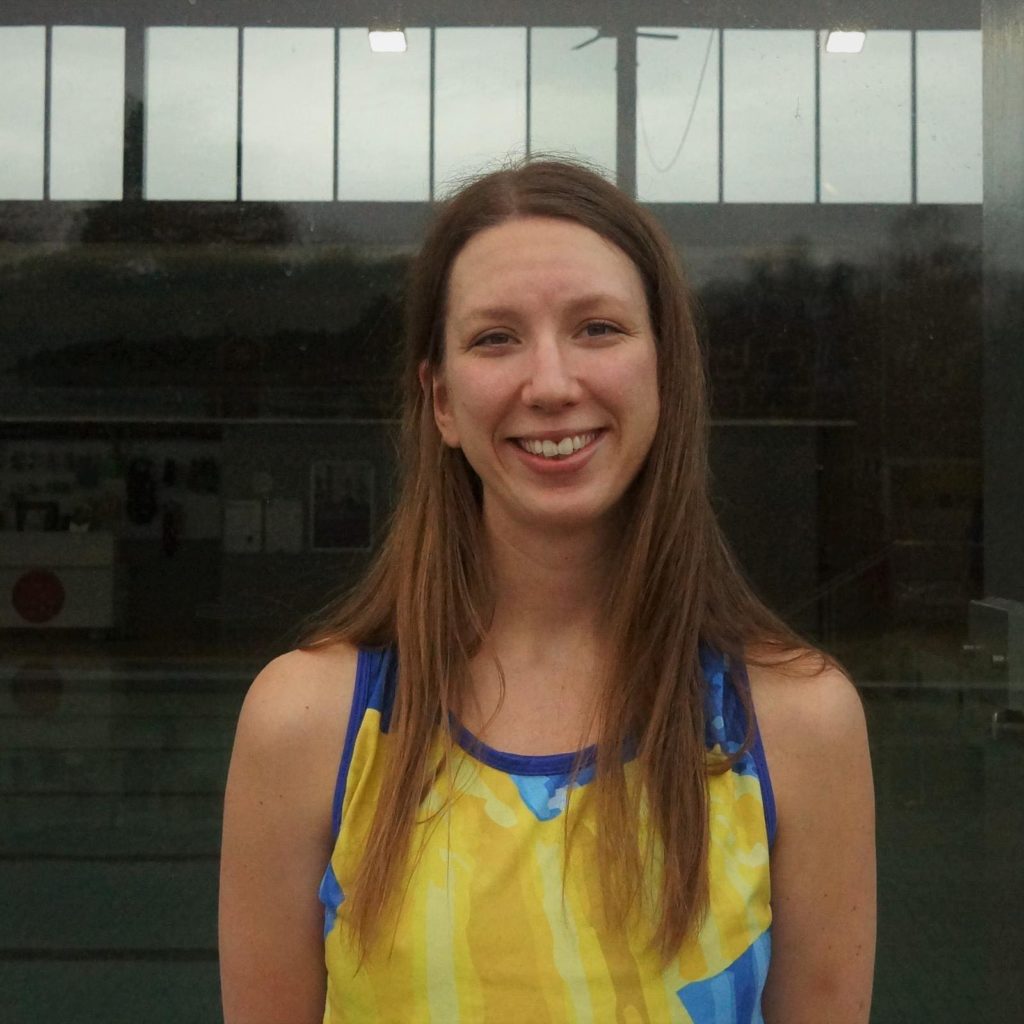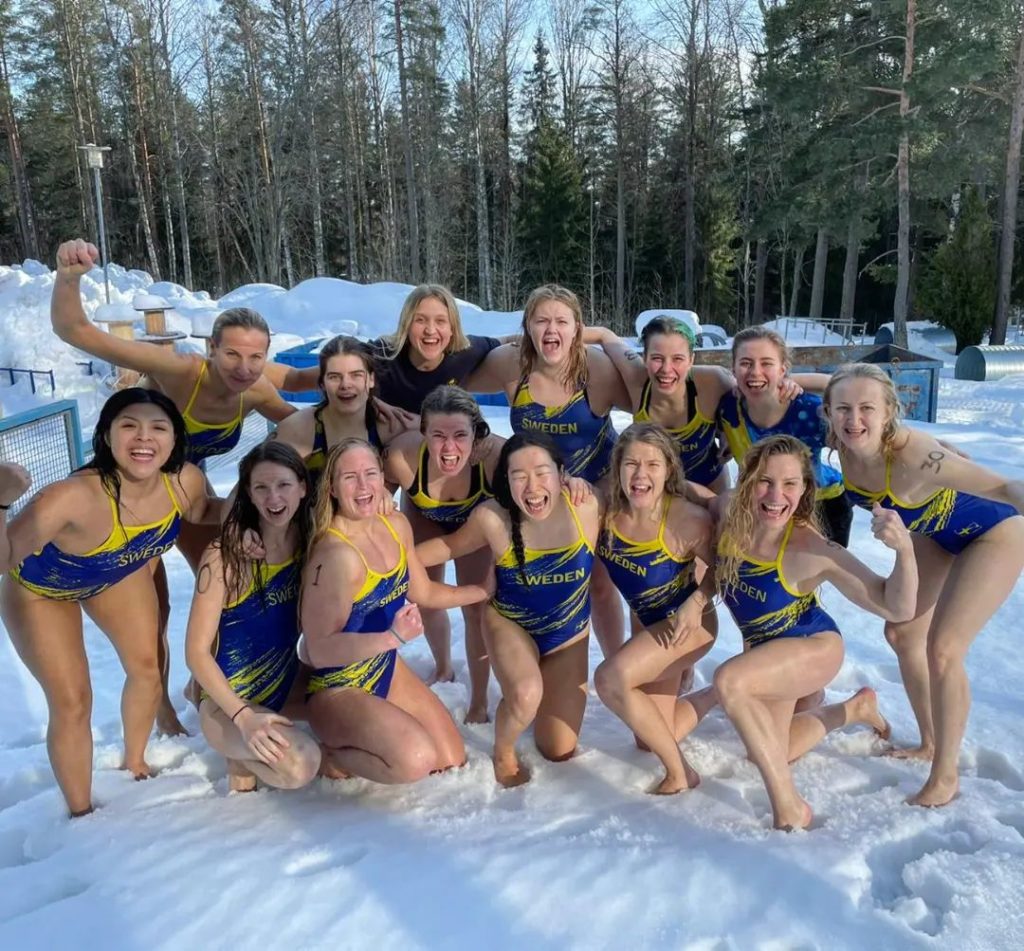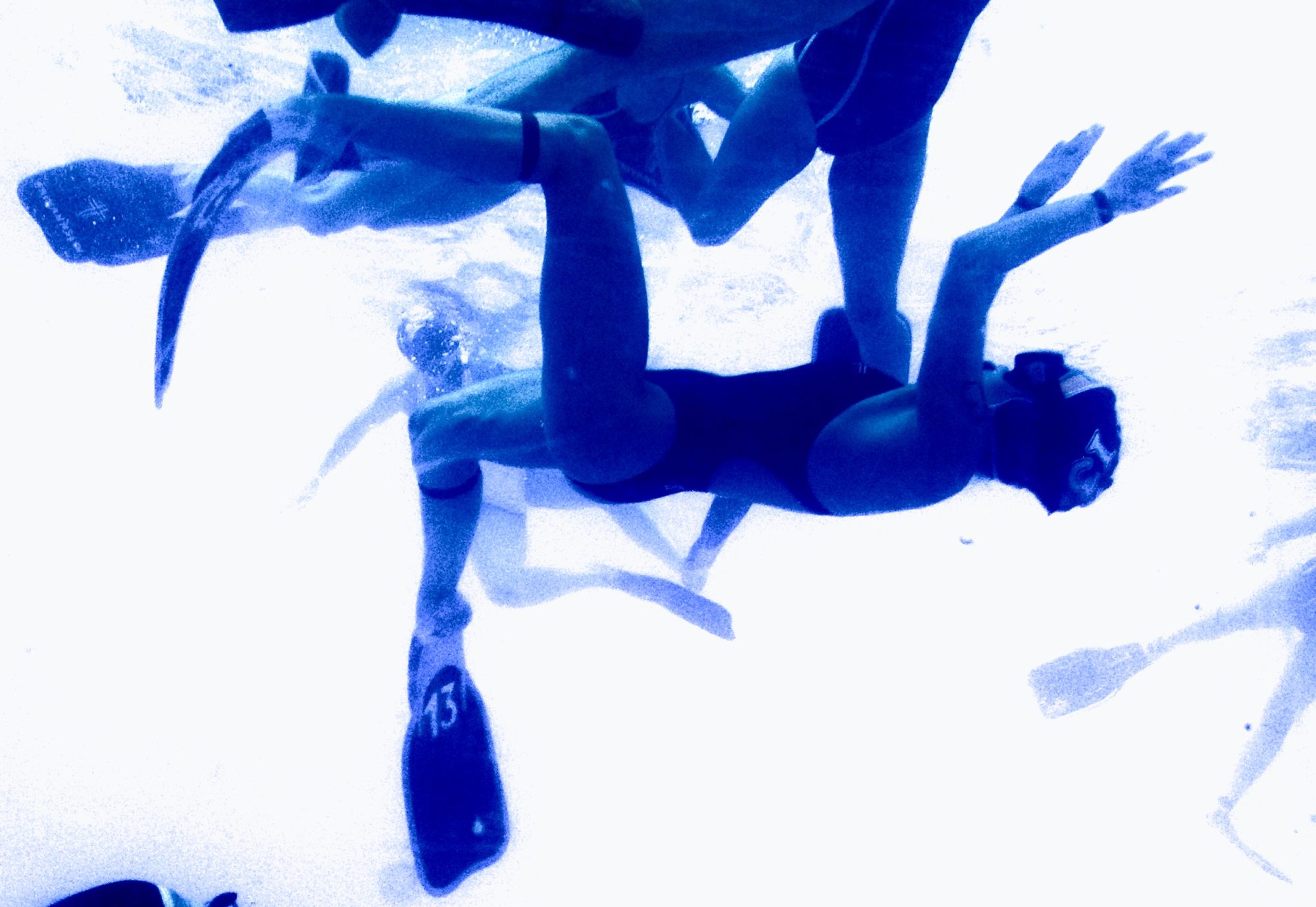
Märta Martin-Åkesson was a last minute addition to the Swedish women’s national team.
They found an old U21 spaghetti strap swimsuit for her at the last training camp in Oxelösund.
Players on national team reserve lists usually do not go to championships. And if they do get promoted, it is uncertain how much playing time they can look forward to. When Märta Martin-Åkesson moved up to the national team travel squad headed to Helsinki at the end of February, the coaches did not actually plan for her to see action at the 23d meeting of Denmark, Finland, Norway and Sweden.
As it turned out, with someone else’s name on the back of her suit, she delivered the key assist to break a 0-0 tie in the bronze final against Denmark. Her coaches now call her a “real trooper”.
Martin-Åkesson, who plays forward, came to the sport of rugby late in life. A Stockholmer who only started playing rugby 4 years ago at the age of 26, Martin-Åkesson would have had zero chance of wearing the national colors of Germany, Norway or Colombia. In Sweden, however, the pool of talent has been drying out for many years. The 14th and 15th spots on the squad lacked clear candidates.

At first, coaches Nina Berggren and Wilma Tien simply promoted Märta Martin-Åkesson to the reserve list because she was making rapid progress. It was a mark of distinction for what she was doing, rather than the player she was.
During her childhood in Kalmar, Martin-Åkesson had had some passing exposure to underwater rugby. In the autumn of 2017, she and a friend decided to try new things. Nemo, a club in Stockholm within cycling distance of her home, invited her to give rugby a go. It took a year before she bought her own equipment and attended practice regularly. Most of the Nemo players were men, so she had to cope with a disparity in experience, strength and aggression.
She chose the position of forward. She benefited from a very low key but involved coach named Anders Hansson. She also received help from Daniel de Soto, a forward who once played a round of the Euroleague for Polisen. Still the difficulties would have stopped most.
She had never played a team sport before. The shot put style of passing the ball underwater had to be learned from scratch. She could not accelerate rapidly, so she had to endure many scrums. Scrimmaging meant she had to suffer the humiliation of having the ball pried away time and again. She did not give up and gradually she internalized defensive tactics to protect the ball.
Unfortunately, the opportunities for women to play against women are limited in Sweden today. There is not a single club that can come close to fielding 15 women players from a single town or city. The women’s domestic league is patched up business. The three or 4 teams are constellations that to some degree compete for players. However, Martin-Åkesson got on to a team from Stockholm and other nearby cities. Although the league was badly disturbed by Covid, it gave her an occasional chance to test her abilities in an all women competitive environment.
“I felt it was so constructive that I decided to go to everything [offered to women] just to learn as much as possible,” she recalled.
This included national team training camps, some of which are open.
“I didn’t think that I would be selected for the national team, but just that I should go to everything that I could go to. It’s cool to try and improve at stuff.”
One benefit of the camps was the eye of Jens Westerlin, a men’s national team player who helped out with the coaching. At one of the camps, he noticed the uncertain, lanky girl and asked who she was.
“Jens said that for someone who did not understand the game very well, she was pretty good,” recalled Tien.
What especially impressed him was her receptiveness to instruction.
“Jens said that she did everything that he told her to,” noted the coach.
Westerlin did not dish out praise lightly, so Tien and Berggren paid a bit more attention to the unknown Martin-Åkesson, who had used the pandemic period to hit the gym and increase her strength.

The women’s national team experienced a setback. The regular coaches Ulf “Uffe” Ridell and Johan Fernlund suddenly resigned just a few months before the competition. Kajsa Lindman, the head of the national rugby committee, asked Tien and Berggren, both aged 26, to temporarily fill in until new coaching staff could be found. They had previously coached the junior women together. Still, the responsibility stressed them, not least because both studied full time.
Furthermore, they confronted the psychological difficulty of selecting a team that might have included their old teammates, the veterans with whom they had emotionally bonded when they had been the youngest on the team.
To reduce the administrative duties of coaching they asked the team members for volunteers to take care of pool booking and other time consuming but essential details. Up stepped Martin-Åkesson. She proved herself both capable and efficient. Suddenly, not only did they notice her out of the water, they depended on her.
No one anticipated the appearance of Martin-Åkesson on the reserve list. She herself said:
“I was really happy, I never expected it. I was just so glad that my name even came up in the situation.”
Rugby wise they did not deem her ready for international competition, but the team needed someone on land to assist. So, when Anna Alfredsson, another player was injured or contracted Covid, they decided to promote Martin-Åkesson to the 14th spot on the team, with the understanding that she probably would not play. She would make the trip to Finland to fill water bottles and seep in the atmosphere.
She still needed a national team swimsuit even if it were to remain dry. It was too late to order a new one for her. In fact, Levina Johanson, a goalkeeper from Umeå, brought an IKEA bag of leftover swimsuits from storage. Some 6 players needed to borrow blue and gold spaghetti strap suits to unify the team look. This team was an experimental constellation that might not exist come the European Championship in June. By that time a new head coach might well select a different squad.
The extra suits had the names and numbers of players from the CMAS U21 World Championships that took place in 2018. The personalized touch was inspired by the Euroleague. The suits in the IKEA bag existed because of a mix-up in the order. Players who wanted high back models with wide shoulder straps ended up with spaghetti straps. Having the wrong suits caused chaos among the teenage women players. The head of Swedish rugby, Kajsa Lindman, straightened out the mess in time for Oberhausen by getting new ones. The federation found itself stuck with a batch of rejected suits.
They should have gone to the federation’s office but ended up in Tien’s mother’s storage room and then followed Tien to Umeå and sat in a closet at the pool.
“I tried to sell them to new players, but beginners never wanted to buy a suit with Sweden and someone else’s last name,” explained Tien, who wished the bag and all the memories it evoked would disappear.
Then suddenly, 4 years later, the suits were needed for the Nordic Championships. The botched order became a convenient, cost free solution. Not coincidentally, the U21 players from Oberhausen became a major presence on the team for the first time. There were 5 of them: Agnes Hoas, Elin Strand, Sofie Öberg, Estelle Persson and Levina Johanson. Tien and Berggren found themselves coaching these players a second time.
To say that Tien and Berggren were reaping the reward of their previous efforts would be true but the truth is more complex and interesting. Martin-Åkesson’s arrival would not have been possible if more of the players from 2018 had continued to play and develop. At the time, the 2018 U21 team failed utterly, coming in dead last in Oberhausen, the first ever CMAS World Championship for juniors in the history of the sport.
Oberhausen set an important new benchmark for rugby as a whole. It delivered quality at the top. In the men’s final, Colombia’s Juan Jose Laverde smashed the ball through a nonexistent gap between the German goalkeeper’s head and shoulder to deliver the deciding goal in a tight 2-1 match. The German men, captained by Philip Kreißig, made for a world class opponent. Turkey beat Norway for the bronze, eliminating all the Nordic countries from the podium.
On the women’s side Turkey defeated Colombia 1-0, demonstrating that rugby could be popularized and coached to a high level in the space of a decade. Germany took bronze. The historically strong underwater rugby nations of Norway and Sweden, found themselves pushed down to the bottom of the table. Denmark and Finland did not even send teams. Observers had to ask themselves if there was any future without junior development?
The Czech Republic sent a mixed team of boys and girls. The others crushed them repeatedly. In group play the Czechs allowed 94 goals in the space of three games. They did not manage to score a single one in return. The other competitors cheered the Czechs, hoping that they would return to future events better prepared. Still, there was a general understanding that absurd disparities damaged rugby’s image.
Tien and Berggren took on the coaching assignment in part to prepare as many future players for the women’s senior national team as possible because they did not want to spend their careers playing for a nation that would never contend for medals. In essence, the two were trying to do what they could to reverse Sweden’s decline.
At Oberhausen the majority of Swedish junior women did not have the cardio for the 4-day competition. They started out strongly against Colombia in their first match, but their conditioning could not sustain their skills. The full length games soon rendered their muscles sluggish and heavy. They came in last, losing every game. They allowed 17 goals while scoring only one. Oberhausen gave the Swedish girls an experience but no triumph or glory.
To 2022 team Sweden ranks came more newcomers: Felicia Johnsson, Sara Nilsson and Elin Hoas, the older sister of Agnes. In short, the team bet on a collection of inexperience, bad experience and youth. However, the green team in the old U21 suits still had three elite veterans: Theresa Blennert, 35, Ann-Sofi Krakau, 39, and Kajsa Lilja, 40. Did they approve of the changes by Tien and Berggren?
Part of constructing a team involves psychology.
“Märta and Felicia are two blank pages who take instructions fantastically well and they give the team energy,” explained Berggren, who feared running out of teammates.
And Sweden literally ran short of players in Helsinki when Öberg strained her shoulder and Johnson twisted her ankle. Suddenly only three defensive backs remained on Saturday. Small and medium crisis broke out. Öberg would have played, but worsening her shoulder would have been too costly in the long run. So, they had to tell Johanson to get her out of the water right before the second game.
To restore the fourth back, Tien switched down from forward and Martin-Åkesson was told to put on her suit and warm up. She had just 5 minutes to make the mental transition before the match against Finland. The rest of the team had already jumped in the water. The Swedes needed a victory over the Finns to advance to the final.
Only when Tien and Berggren looked for Martin-Åkesson to tell her to turn in the team list to the officials did they remember that she was now playing. On top of all this, Berggren’s suit had been missing and she had had to get another one out of the IKEA bag just before warm up.* Tien and Berggren later admitted that they do not understand how the great player coaches hold it all together.
The decision to put Martin-Åkesson into the lineup entailed risk, for as many know, the mistakes of a single weak player can cause a team to collapse. But it was now time to forget it all and put faith in the team as it was.
Martin-Åkesson believed in herself: “I didn’t have time to think about much. I thought it was great and I needed to do my damn best to contribute to the team and not screw up.”
By nature or education Martin-Åkesson is not the sort of person who suffers from competition anxiety.
“I was mainly nervous that I wouldn’t have time to get my suit and gear on, pee and get to the right place at the right time. Of course during the match I was on edge the whole time and my pulse was elevated along with the above normal increase in adrenaline.”
Finland kept the match 0-0 as needed. The Swedes were disappointed but the rookie forward held up, not allowing the Finns into score. Martin-Åkesson’s team would play for bronze in their final game.
The test of the rookies, a big portion of the team, depended on how the entire team accepted the strategic changes the coaches demanded. Simplified, Tien and Berggren wanted the backs and goalkeepers to take part in forechecking when on defense at their own basket instead of just exchanging. Did they consider this an innovation?
“Oh, not really! The aggressive back [in defensive strategy] was already incorporated by Johan and Uffe,” laughed Berggren.
“Stux [another former national team coach] tried,” added Tien.
The strategy had never been implemented due to a combination of factors, according to the two.
The strategy further called for Martin-Åkesson and the other forwards to resist the temptation to chase. They were to lurk and steal balls when the ball carriers were distracted.
On offensive, the two coaches wanted the whole team to contribute to attacks. No one should lie and watch Krakau and Blennert, the two most dangerous goal threats, try to score; they should get close to the action to help finish the opportunities.
In the Sunday bronze match against Denmark, whom Sweden squeaked by 1-0 on Saturday, the Danes proved stubborn again. In the second half after a strong attack by Denmark, the Swedes got the ball to the other side and then suddenly in a second wave Martin-Åkesson was on the bottom in exactly the right spot for a pass. And when she got it she pressed forward without hesitation. Elin Hoas screened out the back, allowing Tien to take a pass and drive the ball past the goalie.
“That was a well built up moment,” declared the livestream commentator.
Martin-Åkesson remembered the moment too:
“I had a Dane on me right away but I saw Wilma and Elin at full speed and so I thought that I had to pass while holding the Dane away from them. Then I saw the goal about the same time I surfaced and was so darn happy.”
After the weekend, Krakau posted her approval on social media:
“What a weekend with this team. Seldom have I played at the international level with a team with such great desire and such great courage to unsparingly dig its way through to the opponent’s basket.”
Looking forward to future competitions, she concluded that the future looked bright for Sweden since the women’s average age was just 26.
It is possible that there are a few former national team players who will now make a new effort to get back on the team. So, Martin-Åkesson is hardly assured of a spot in June at the European Championships in Stavanger. The Swedish Sport Diving Federation has yet to announce who will take over after Tien and Berggren, who were temporary replacements.
*Both Tien and Berggren keep their wet suits in Systembolaget (the Swedish state alcohol retail monoply) plastic bags. After the match they discovered that Berggren’s suit was in Tien’s pack.
Here is a YouTube link to Martin-Åkesson’s assist.

